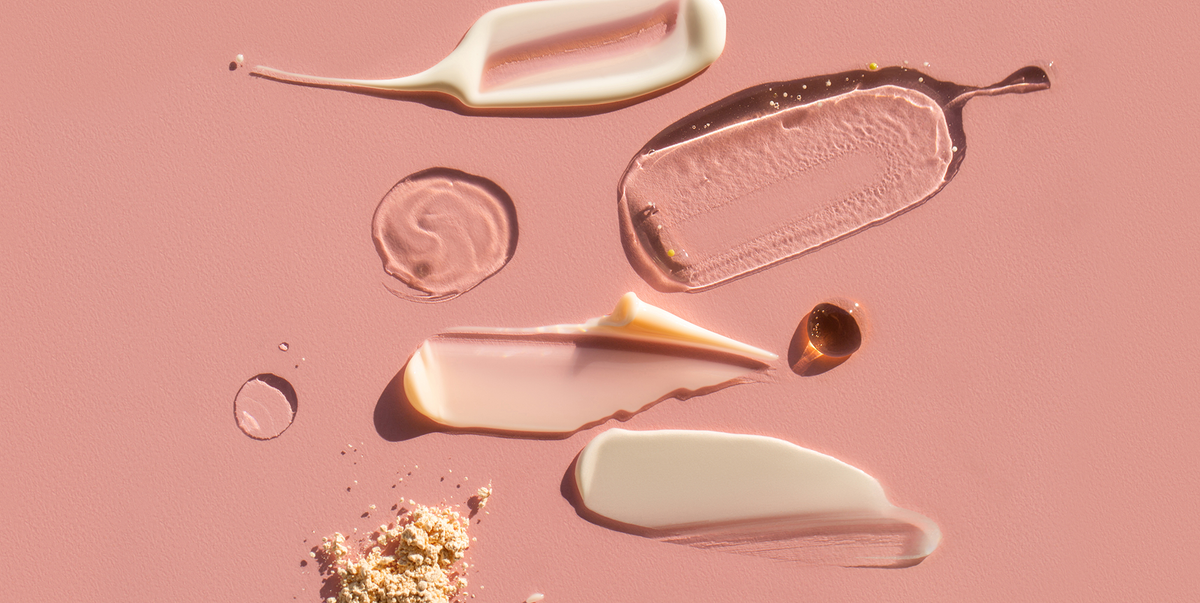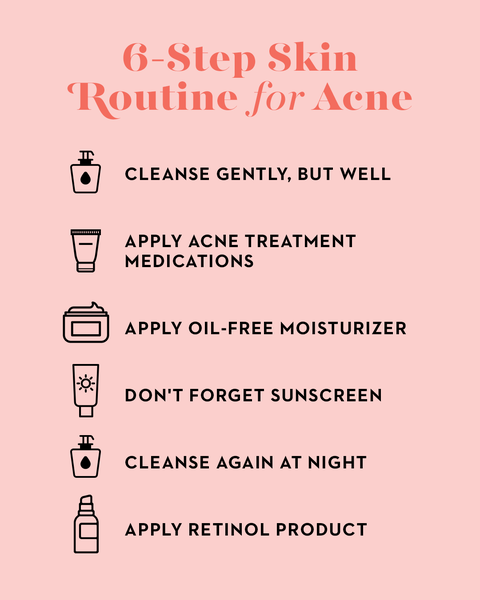Acne, unfortunately, is not just limited to teenagers. Even if it’s been decades since you walked the halls of your high school, you can still wake up with a big red zit on your nose or a sprinkle of whiteheads across your cheeks. In fact, the battle against blackheads, whiteheads, pimples and cystic acne carry right through to menopause. But by zeroing in on the right acne products and sticking to a steady skincare routine, it is possible to achieve clearer skin.
“I have people come into my office every day in their 30s, 40s, and 50s who have acne,” says Debra Jaliman, M.D., an assistant professor of dermatology at Icahn School of Medicine at Mount Sinai and author of Skin Rules: Trade Secrets From a Top New York Dermatologist. “I tell them we can definitely get it under control, but it’s like exercise — you have to be consistent with your routine every day.”
With the endless array of products out there claiming to deep-clean your skin and banish acne forever, though, it can be overwhelming to narrow it down to a simple, workable system. So we asked three top dermatologists to break it down for you.
What exactly is acne — and how it caused?
Your skin has millions of tiny sebaceous glands, which are connected to hair follicles all over your body, and produce an oil called sebum to protect your skin. However, a few things can happen that keep that oil from escaping properly through the follicles. Hormones can cause the sebaceous glands go into overdrive, and the excess oil they produce can get blocked by dead skin cells, clogging up the pores and causing acne. In teenagers, the onset of puberty usually kickstarts the hormone rush, but hormonal acne is very common in adults as well, says Howard Sobel, M.D., an attending dermatologist at Lenox Hill Hospital and founder of Sobel Skin, who explains that pregnancy, your menstrual cycle and starting or changing birth control pills can speed up oil production, causing pimples to form. Also, when you’re stressed (and who hasn’t been recently?), your body produces cortisol, which can stimulate the oil glands, leading to an outbreak.
Your pores can also get clogged due to irritation or a reaction to a product or fabric (such as a hat or yes, a pandemic-era face mask), Dr. Sobel adds. In some cases, an acne-like breakout can also be caused by an overgrowth of yeast in the hair follicles, especially on the upper chest and upper back. Certain medications, such as corticosteroids, can cause acne, and according to Dr. Jaliman, too much dairy in your diet may also play a role. The best way to discern what is causing your breakouts is to check in with your dermatologist.
Once those pores are clogged, they can cause several different variations of acne, including:
- Whiteheads: This type of acne appears when excess oil and dead skin cells clog the opening of the pore; it looks like small flesh-colored or white-colored bumps.
- Blackheads: These are similar to whiteheads, but when the material clogging the pore pushes through and becomes exposed to the air, it reacts with oxygen and turns black.
- Pimples: The classic red spots pop up when bacteria gets trapped inside the pore with the oil and dead skin, leading to inflammation.
- Cystic acne: These hard and painful bumps can feel like a marble under the skin — they occur when the oil, dead skin and bacteria penetrate deeper into the skin.
The Best Skincare Routine to Prevent Acne
The first thing you should do is take a good look at all the products you use on your skin (including makeup) and hair, says Dr. Jaliman. “The biggest mistake I see people making with their acne routine is that they use too many products and don’t check the labels for ingredients,” she says. Look for the words non-comedogenic, non-acnegenic or oil-free on the products you use, which indicate that there are no oily, pimple-causing ingredients, she says.
Then, follow these six dermatologist-recommended skincare routine steps daily:
Step 1: Wash your face — gently!
Though you may be tempted to scrub away at your face like you’re trying to scrape mud off your favorite pair of shoes, that can actually make things worse, says Elyse M. Love, M.D., of Spring Street Dermatology in New York. “Often patients believe that acne is a result of excess dirt or oil on the skin and they attempt to over-cleanse and over-exfoliate the skin,” she says. “Although routine cleansing is important, acne is an inflammatory condition, so this over-cleansing can actually irritate the skin and further drive the process.” Dr. Sobel adds, “It’s important to not overstrip the skin, as this compromises the skin’s protective barrier, which can lead to further breakouts, irritation, redness and uneven skin texture and tone.”
All three dermatologists I spoke with recommended washing your face with a gentle foaming cleanser in the morning. But you have a choice here: If you prefer to dab on a spot treatment separately — or your doctor has prescribed an RX acne medication — then stick with a mild, non-medicated cleanser in the morning, such as Neutrogena Ultra Daily Face Wash for Sensitive Skin.
However, if you want to combine the first two steps, go for a foam cleanser that contains an acne-fighting ingredient. If you have whiteheads or blackheads, look for a cleanser with salicylic acid to slough off the damaged top layer of skin, clearing away dead skin cells before they can get lodged in your pores (try Medik8 Clarifying Foam, which also includes antibacterial and anti-inflammatory tea tree oil). If you have red, inflammatory acne look for a cleanser with benzoyl peroxide, which targets surface bacteria (CeraVe Acne Foaming Cleanser contains benzoyl peroxide, niacinamides and ceramides, which Dr. Jaliman recommends for combination skin; or try PanOxyl Foaming Wash which has 10% benzoyl peroxide).
It’s important to note that the method you use to clean your skin is just as important as the product you use, so get rid of any rough washcloths, sponges or other irritating materials. Dr. Jaliman recommends using a cotton pad or baby washcloth to apply the cleanser, though it’s crucial to use a clean washcloth each day, so you’re not just rubbing old dirt back on your face. You can even just use your hands, splashing on enough water to rinse the cleanser off, says Dr. Love. But she cautions you to only use lukewarm water, as hot water can irritate the skin — though a splash of cool water afterward can balance the skin, tighten and refresh, adds Dr. Sobel.
Step 2: Apply an acne treatment medication
If you chose to use a simple cleanser in step 1, here’s your chance to spot treat with the more powerful stuff. After washing, let your skin dry — pat gently with a soft towel rather than rubbing — and then try an over-the-counter treatment, such as CeraVe Salicylic Acid Acne Treatment Gel or La Roche Posay Dual Action Acne Treatment.
It can take an over-the-counter treatment at least six weeks to work, the experts say — at that point, if you’re still not seeing any results, you should consult with a dermatologist, who can prescribe a stronger medication, such as Dapsone gel. Dr. Love offers this savvy advice: “If you live in an area where there’s a three-month wait to see a dermatologist, make the appointment as soon as you start the over-the-counter drugstore topicals as a backup plan,” she suggests. “You can always cancel if you don’t need it!”
Step 3: Apply an oil-free moisturizer
When you’re worried about oily skin and clogged pores, moisturizer may seem unnecessary, but the opposite is actually true: “Moisturizers help keep the skin’s oil production in balance,” says Dr. Love. “It also helps acne suffers tolerate acne medications, which are often drying. The key is to stick to oil-free, non-comedogenic moisturizers.” One of Dr. Love’s favorites is La Roche Posay Double Repair Face Moisturizer. Dr. Jaliman recommends using an aloe-based, noncomedogenic moisturizer with hyaluronic acid, which protects collagen. One that fits the bill: Fresh Rituals Aloe Vera Moisturizer. Other noncomedogenic options include Cetaphil Gentle Clear and Aveeno Clear Complexion, both of which contain a hit of salicylic acid. For more top-tested recommendations from the Good Housekeeping Institute Beauty Lab, check out our list of the best moisturizers for acne-prone skin.
Step 4: Don’t forget sunscreen
Sunscreen is a crucial step to protect skin from UV damage, but when you have acne-prone skin, you should choose a sunscreen that won’t clog pores or make your breakouts worse, says Dr. Jaliman, who loves EltaMD UV Clear Broad Spectrum SPF because it contains anti-inflammatory niacinamide, which reduces redness. Another sunscreen recommended by the experts in the GH Beauty Lab: La Roche Anthelios SPF 60 Dry Touch Clear Skin Sunscreen, which has a lightweight feel.
Step 5: Cleanse again at night
When you cleanse at night, you’ll want something that can gently remove the makeup, oil and debris your face has accumulated during the day, says Dr. Sobel, who recommends a gel-based, surfactant-free cleanser, like Vichy Normaderm Phytoaction Daily Deep Cleansing Gel, which contains salicylic acid and is a favorite of the GH staff. If you like to use a toner as a follow-up step, just make sure it’s oil-free says Dr. Jaliman, like the ones on our list of the best toners for acne-prone skin. Meanwhile, Dr. Love recommends doing a double cleanse by using micellar water first — try the ones from Avene, Garbier, or Bioderma — then following that up with your cleanser.
Step 6: Apply a retinol product before bed
Before you go to bed, there’s one last important step to achieving clear skin: smoothing on a retinol product. What is retinol? It’s the over-the-counter version of the vitamin A derivative Retin-A, which reduces wrinkles and — key for acne control — unclogs pores. “Retinol is a great multi-tasking acne treatment for adults,” says Dr. Sobel. “It helps speed up cell turnover and regeneration and exfoliates keratinocytes, the cells on the outermost layer of the skin. It also works to unclog pores and keep skin looking youthful while minimizing and preventing fine lines and wrinkles. ” Three to try: Differin Adapalene Gel, La Roche-Posay Effaclar Adapalene Gel, and Sobel Skin 4.5% Retinol Complex Night Treatment. Dr. Sobel recommends starting off slowly with any retinol product. “Try it one or two days a week to build up a tolerance and avoid irritation,” he says. “Gradually, move up to four time a week, and then daily if needed.”
The bottom line: “Be patient and consistent with your regimen and don’t give up,” Dr. Sobel adds. “It takes time to clear and fade existing blemishes while preventing future breakouts. It won’t happen overnight, but it will happen.”
This content is created and maintained by a third party, and imported onto this page to help users provide their email addresses. You may be able to find more information about this and similar content at piano.io


